Search results for: 'Bronze a'
-
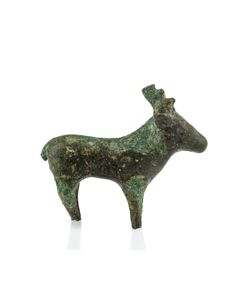 Roman bronze figurine of a stag from the Rhineland
Roman bronze figurine of a stag from the RhinelandFound 1966 - 1981 near the Roman city of Novaesium, today's Neuss in Germany, an early Roman foundation and with this one of the oldest cities in Germany.
Price: on request Bronze Age flanged axe
Bronze Age flanged axeWorking axe from the Late Bronze Age of Europe in great condition. Typologically, it is a flanged axe head.
Price: on request Bronze Age flanged axe
Bronze Age flanged axeWorking axe from the Late Bronze Age of Europe in great condition. Typologically, it is a flanged axe head.
Price: on request Neck ring of the Urnfield culture
Neck ring of the Urnfield cultureThis bronze ring is an early variant of a torc. The piece of jewellery was found in Southern Germany and dates to the Late Bronze Age.
Price: on request Palstave axehead with triangle decoration
Palstave axehead with triangle decorationExtremely well preserved piece from a Bronze Age hoard found in Manston, UK. 1400 to 1150 BC. This axe belongs to a very rare type.
Price: on request Palstave axehead with triangle decoration
Palstave axehead with triangle decorationExtremely well preserved piece from a Bronze Age hoard found in Manston, UK. 1400 to 1150 BC. This axe belongs to a very rare type.
Price: on request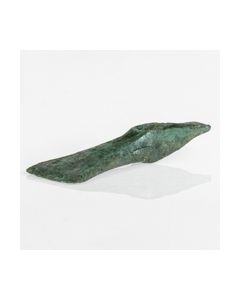 Palstave axehead with decoration
Palstave axehead with decorationExtremely well preserved piece from a Bronze Age hoard found in Manston, UK. 1400 to 1150 BC.
Price: on request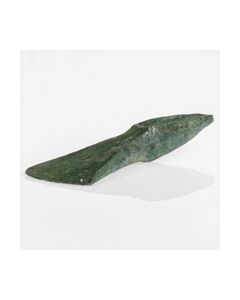 Palstave axehead with decoration
Palstave axehead with decorationExtremely well preserved piece from a Bronze Age hoard found in Manston, UK. 1400 to 1150 BC.
Price: on request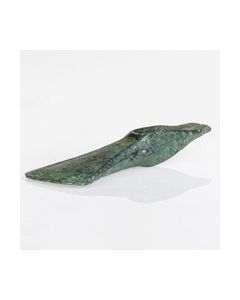 Palstave axehead with decoration
Palstave axehead with decorationExtremely well preserved piece from a Bronze Age hoard found in Manston, UK. 1400 to 1150 BC.
Price: on request Palstave axehead with decoration
Palstave axehead with decorationExtremely well preserved piece from a Bronze Age hoard found in Manston, UK. 1400 to 1150 BC.
Price: on request Palstave axehead with decoration
Palstave axehead with decorationExtremely well preserved piece from a Bronze Age hoard found in Manston, UK. 1400 to 1150 BC.
Price: on request Neolithic flint dagger from Denmark
Neolithic flint dagger from DenmarkDouble-edged blade and flat shaft made of beautiful flintstone. A status symbol from the transitional period between Late Neolithic and Early Bronze Age.
Price: on request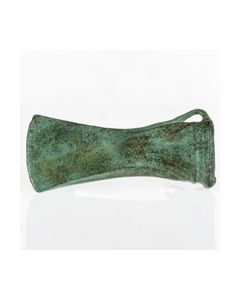 Socketed axe head from Southern Germany
Socketed axe head from Southern GermanyA typical bronze tool of the late Urnfield culture or early Hallstatt culture. It was found near Regensburg in Southern Germany by a voluntary archaeologist.
Price: on request Viking stirrup mount
Viking stirrup mountOpenwork bronze plate from the 11th century. It was once attached to a horse harness strap. The beautiful decorations are typical of the art of the Vikings.
Price: on request Roman artefacts from the Rhineland
Roman artefacts from the RhinelandFragments of Roman pottery vessels, bronze and glass fragment, as well as a piece of a mosaic. Finds from the Roman city of Novaesium, today's Neuss in Germany.
Price: on request Roman plate brooch
Roman plate broochOval bronze brooch with a setting for a glass insert. From the Roman imperial period. Published in two stardard works on ancient brooches by Richard Hattatt.
Price: on request Bronze Age bracelet with incised decoration
Bronze Age bracelet with incised decorationThe jewellery was made in Europe during the 2nd millennium BC. Nice, dark patina.
Price: on request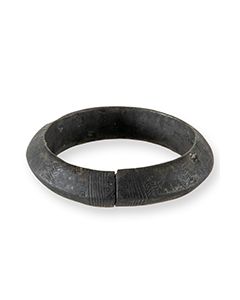 Bronze Age bracelet with incised decoration
Bronze Age bracelet with incised decorationThe jewellery was made in Europe during the 2nd millennium BC. Nice, dark patina.
Price: on request Roman key ring
Roman key ringFinger ring made of bronze with a key. From the Roman Imperial period, around the 2nd century. A find from the Roman city of Novaesium, today's Neuss in Germany.
Price: on request Sword from the European Bronze Age
Sword from the European Bronze AgeWonderfully preserved bronze weapon from the Late Bronze Age around 1200 BC. Of the Reutlingen type, made in the region of today's Germany or surrounding countries.
Price: on request Large decorated violin bow fibula
Large decorated violin bow fibulaImpressive piece of jewellery because of its size and decoration. From Central Europe, made during Late Bronze Age or Early Iron Age.
Price: on request Neolithic axe head
Neolithic axe headFinely crafted tool from the New Stone Age of Europe. A specimen of the thick butted type.
Price: on request Neolithic axe head
Neolithic axe headFinely crafted tool made of nice dark grey flint. From the New Stone Age of Europe. A specimen of the thick butted type with thin blade.
Price: on request Neolithic axe head
Neolithic axe headFinely crafted tool from the New Stone Age of Europe. A specimen of the thin butted type.
Price: on request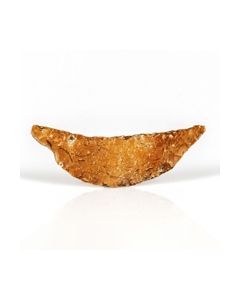 Small Neolithic sickle from Northern Germany
Small Neolithic sickle from Northern GermanyThe crescent-shaped blade is made of reddish brown flint. This tool represents an intermediate state within the radical transition from Neolithic to Bronze Age.
Price: on request Large Visigoth bow brooch
Large Visigoth bow broochImpressive fibula of the Visigoths from the Migration Period. With five originally preserved glass inserts.
Price: on request Double spiral pendant from Bronze Age Central Europe
Double spiral pendant from Bronze Age Central EuropeTypical decorative element of a wealthy woman's dress in the European Middle Bronze Age. Several of these spiral pendants were worn around the waist. Similar to belt mounts or charms. 1500 to 1200 BC.
Price: on request Double spiral pendant from Bronze Age Central Europe
Double spiral pendant from Bronze Age Central EuropeTypical decorative element of a wealthy woman's dress in the European Middle Bronze Age. Several of these spiral pendants were worn around the waist. Similar to belt mounts or charms. 1500 to 1200 BC.
Price: on request Neolithic axe head with through hole
Neolithic axe head with through holeFinely crafted tool from the New Stone Age of Europe. Made from greenish grey rock. With a through hole at the neck as a remarkable feature.
Price: on request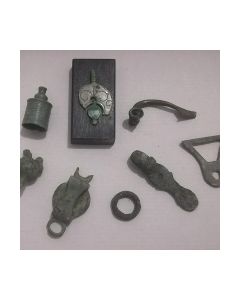 Eight Roman bronze artefacts
Eight Roman bronze artefactsVarious artefacts in different states of preservation. Finds from the Roman city of Novaesium, today's Neuss in Germany.
Price: on request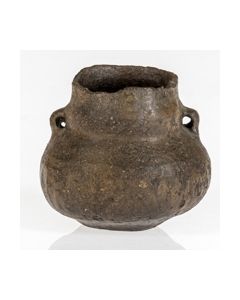 Vessel of the Urnfield culture
Vessel of the Urnfield cultureNicely preserved pottery dating to the Urnfield period, the transition between Bronze Age and Iron Age in Central Europe. Found in Southern Germany. 1200 to 800 BC.
Price: on request Large neolithic axe head
Large neolithic axe headA tool from the Early Neolithic of Europe. Nicely polished and impressive by its size and weight.
Price: on request Disc brooch from Roman Britain
Disc brooch from Roman BritainNicely enameled brooch with a Romano-Celtic sunburst design. From the 2nd century AD. Published in two stardard works on ancient brooches by Richard Hattatt.
Price: on request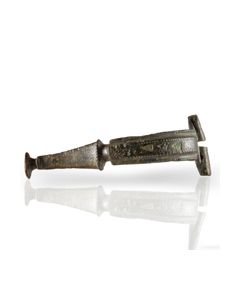 Roman Hod Hill brooch from the Hattatt collection
Roman Hod Hill brooch from the Hattatt collectionNice and rare enameled variant of the Hod Hill type. Found in Norfolk, UK. The piece is published in two books by Richard Hattatt.
Price: on request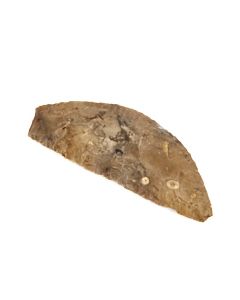 Neolithic sickle from Northern Germany
Neolithic sickle from Northern GermanySmall crescent-shaped blade made of beautiful grey flint. This tool represents an intermediate state within the radical transition from Neolithic to Bronze Age.
Price: on request Neolithic sickle from Northern Germany
Neolithic sickle from Northern GermanyCrescent-shaped blade made of beautiful grey flint. This tool represents an intermediate state within the radical transition from Neolithic to Bronze Age.
Price: on request

